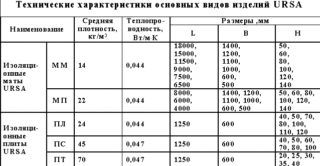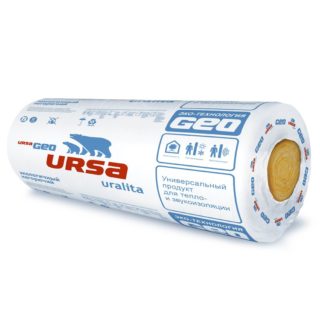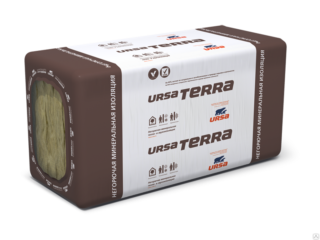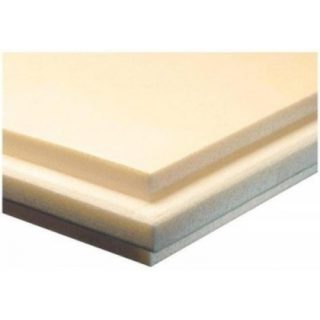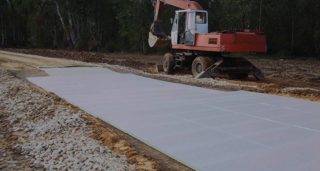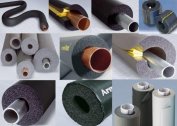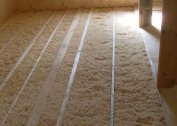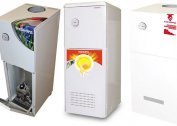Minvat Ursa is used for insulation of walls, roofs, communications. The insulation retains heat and reduces incoming noise. The material is characterized by quality characteristics and has a long service life. The company has been producing Ursa insulation since 2002 and has developed a number of innovative technologies for the production of products.
Ursa Material Features
Universal insulation Ursa effectively reduces heat loss and forms a comfortable microclimate in the room. Low specific gravity helps to reduce the volume of building materials, energy consumption.
The URSA trademark produces 2 types of products:
- thermal insulation, which is based on Ursa polystyrene foam (EPS);
- based on fiberglass.
The first category includes material made by extrusion technology. Foam particles combine with the foam under pressure and high temperature. The hot mass passes through the extrusion head of the unit and the extruded polystyrene Ursa is obtained.
Warming of the second category is carried out by combining dolomites, quartz sand and soda. The substances melt, additives are added to the mass for bonding the components. The hot composition is pressed through the nozzles of the extrusion unit.
Technical characteristics of mineral insulation
The mineral insulation category includes materials made from natural constituents, such as fiberglass. Products are sold in plates or rolls. The structure does not include phenolic substances to bind the ingredients, so Ursa mineral wool is an environmentally friendly product.
The composition contains sand, soda, other non-combustible materials, so the insulation is characterized by increased fire safety. The manufacturer indicates a period of 40-50 years of operation without destruction and loss of quality.
Insulation density
The density of the material is determined by the ratio of weight to volume. For glass wool, the indicator is determined on a scale of 15-85 kg / m3, depending on this, the scope of use is selected. In private homes, material with an index of up to 30 kg / m3 is used, and industrial insulation requires a higher density foam.
Thermal conductivity
The characteristic shows the ability of rolled and plate materials to conduct heat from heated to cold layers. Energy transfer occurs due to the movement of elementary particles in the composition of the insulation. Ursa mineral wool has a low ability to transfer heat, so good insulation of structures and pipelines is obtained.
The lower the thermal conductivity, the better the protection against cold. In mineral wool, the indicator is within the range of 0.031-0.045 W / mK. This amount of energy passes through the thickness, which indicates the high thermal insulation qualities of the interlayer.
Temperature application
The characteristic determines the temperature range at which the insulation preserves the specified properties. The manufacturer guarantees that Ursa expanded polystyrene does not change the declared qualities at an ambient temperature of -60 ° C. The upper indicator is + 310˚С.
These indicators relate only to the atmosphere, since the surface of the insulation can withstand other temperature loads, the limit of which is + 100 ° C, and some categories retain their properties at + 180 ° C.The insulation belongs to the universal class and is suitable for protection from the cold of various structural elements in any climate.
The material goes on sale in the form of rolls or in the form of plates. Roll products are produced in a thickness of 5-20 cm, the width varies in the range of 60-120 cm. The length of the mats is 3-18 m, and the sheets are produced in the size of 1.25 m.
Mineral component line
Mineral wool is fibrous depending on the initial component underlying. The structure is spatial, corrugated, the layers are divided horizontally or vertically.
The manufacturer designates products depending on the raw material composition:
- Fiberglass products are marked with the Geo prefix. Products are classified as safe for humans and environmentally friendly materials.
- A product with the PureOne index is created on the basis of glass filaments. The composition has acrylic components. This type of insulation is installed to protect against cold in children's institutions and hospitals.
- The non-combustible Terra is ideal for the insulation of wooden structures. The composition includes natural components, the insulation does not harm the environment and humans.
- Thermal insulation based on extruded polystyrene foam is marked with the XPS prefix and is a durable and reliable insulation variant of the insulation.
Ursa thermal insulation is manufactured in accordance with technological standards that regulate the content of the binder.
Ursa GEO
The heat insulator is allowed for use in rooms with a high risk of ignition, since the material does not emit harmful components when heated.
Urs Geo products are available in the range:
- Light;
- Pitched roof;
- Frame P;
- Mini;
- Facade;
- Noise protection%
- Universal plates.
Mats with one foil side are designated M-11F and M-11, bilateral - M-25F, M-25, M-15. Plates are marked P-60, P-15, P-45, P-20, P-30.
With a small specific gravity, Geo brand products provide high-quality protection against cold and noise thanks to the original fibrous structure. The material does not decompose, does not burn, rodents and insects do not settle in the thickness.
Ursa PureOne
The characteristics of Ursa insulation show that 95% of the material consists of natural substances that underwent quality control during the production process. The material is produced in accordance with international sanitary standards and is included in the class of environmentally friendly insulators.
The names of the line:
- 35QN rolls measuring 1200 mm x 3900 mm;
- 34PN plates with a size of 1250 mm x 600 mm);
- 37RN rolls measuring 1200 mm x 100 mm).
The products are flexible when installed in curved structures due to sophisticated fibrous elements in the structure. The material does not emit dust and odor during installation. White color is obtained through the use of quartz sand.
Ursa TERRA
Products were developed for private buildings, but also meet the requirements of professional construction. Plates of this type are small in size and stiff with sufficient elasticity and flexibility.
An assortment of Terra brand insulation is produced:
- plates 34 PN;
- mats for insulation of highways and ventilation ducts 34 RN.
Sheets are characterized by a good index of thermal and sound conductivity, shows moisture-resistant qualities. Production technology involves the use of water-repellent additives.
EPS line of materials
Materials have a low thermal conductivity index (0.028-0.035 W / mK), have increased strength and low specific gravity (45 kg / m³), which reduces the weight of the structure. Extruded polystyrene foam is characterized by closed cells in the structure, the diameter of which does not exceed 0.2 mm. This structure provides moisture resistance in wet conditions.
URSA XPS
In the product category EPS only one type of product is produced. The material has universal application, but is most often used for insulation work in the construction of embankments of railway tracks, runways, lower and underground floors of buildings.
The range of the URSA XPS line:
- high-strength material N-V, sold in slabs 60 x 125 cm;
- N-III sheets are available with straight and stepped side edges;
- N-III-G4 boards are produced with a thickness of 3-10 cm, size 60 x 125 cm.
Products do not respond to acids, fats, alkalis, lime, bitumen and other corrosive substances, but decompose on contact with tar, hydrocarbon, gasoline and formic acid.
Main advantages
The service life without loss of properties is comparable with the operating time of structures, the insulator ages at the same time with them and does not require replacement. The high tensile strength of extruded polystyrene foam is its positive quality, because of which the material performs protective functions and works as additional structural elements that can withstand some loads.
Advantages of Urs materials:
- ecological cleanliness;
- increased soundproof qualities;
- long term of work;
- resistance to temperature jumps;
- wide range of applications;
- elasticity and resilience;
- fire resistance;
- ease;
- vapor permeability and biostability;
- not subject to decomposition and decay.
There are some negative points to using. For example, mineral wool decomposes in direct contact with alkalis, and small fibers are strewed from glass wool during cutting.
Fields of application
Universal insulation Ursa is used in the process of any construction. Universal characteristics allow the use of protection for complex curved surfaces.
Areas of use:
- pitched and flat roofs;
- foundations in damp places;
- walls outside, inside and as an intermediate layer;
- partitions;
- heating mains;
- roads and railroad elevations;
- aerodrome strip;
- outbuildings, balconies;
- saunas and baths.
Reliable thermal insulation is set to a minimum thickness, which is comparable to the thicker layers of other materials. Internal insulation from Ursa material does not reduce the horizontal and height dimensions of the room.
Installation of thermal insulation Ursa
Mineral wool is attached to the walls and pressed with 50x50 cm bars so that there is air space between it and the finishing layer. Wooden elements are mounted at a distance of the width of the roll so that they hold the edges of the canvas. Expanded polystyrene plates are glued to the surface of walls or floors using cement-adhesive mortars or polyurethane composition. Before gluing, walls, ceilings or floors are primed for better adhesion. They perform a screed or starting putty using plaster mesh.
For reliable fastening to vertical surfaces, special dowels with a large hat (up to 10 cm) are used. The ventilation gap between the insulation and the wall of the house ends at the bottom and top with air ducts - mounting holes for normal air intake. Rolls and slabs fit tightly together. If the material is placed in 2 layers, the next layer overlaps the joints of the previous one for maximum efficiency.
If a frame is used, the final finish is attached to it in the form of sheets of chipboard, fiberboard, OSV, plastic panels or MDF. Ursa insulator works well with all types of building finishes.

